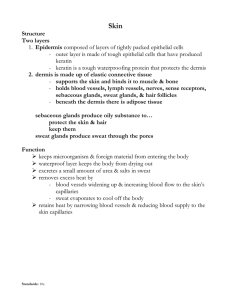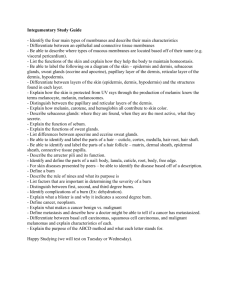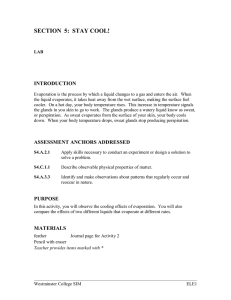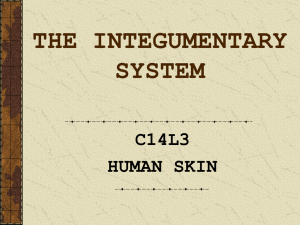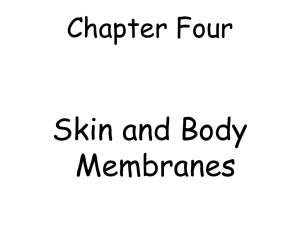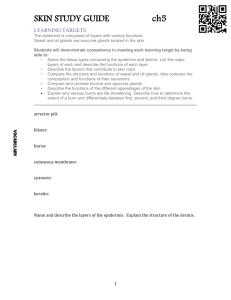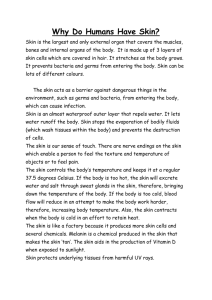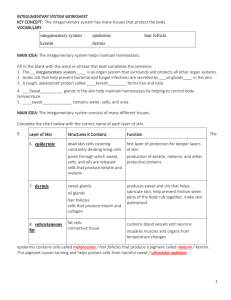Chapter 3 Study Guide: Cells
advertisement
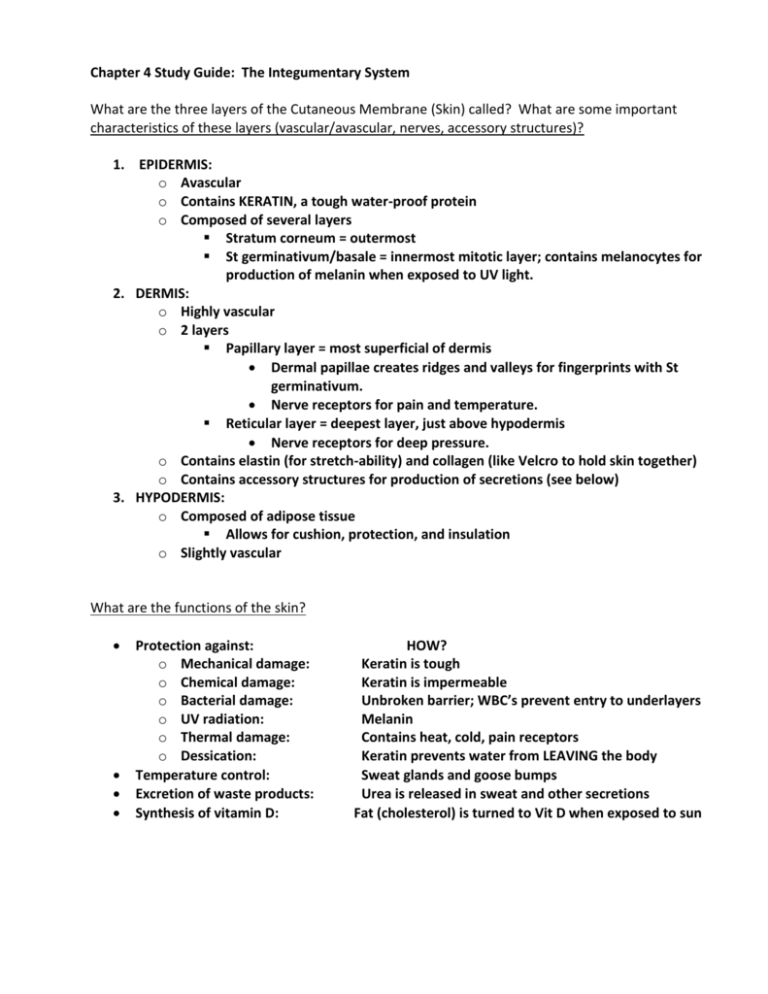
Chapter 4 Study Guide: The Integumentary System What are the three layers of the Cutaneous Membrane (Skin) called? What are some important characteristics of these layers (vascular/avascular, nerves, accessory structures)? 1. EPIDERMIS: o Avascular o Contains KERATIN, a tough water-proof protein o Composed of several layers Stratum corneum = outermost St germinativum/basale = innermost mitotic layer; contains melanocytes for production of melanin when exposed to UV light. 2. DERMIS: o Highly vascular o 2 layers Papillary layer = most superficial of dermis Dermal papillae creates ridges and valleys for fingerprints with St germinativum. Nerve receptors for pain and temperature. Reticular layer = deepest layer, just above hypodermis Nerve receptors for deep pressure. o Contains elastin (for stretch-ability) and collagen (like Velcro to hold skin together) o Contains accessory structures for production of secretions (see below) 3. HYPODERMIS: o Composed of adipose tissue Allows for cushion, protection, and insulation o Slightly vascular What are the functions of the skin? Protection against: o Mechanical damage: o Chemical damage: o Bacterial damage: o UV radiation: o Thermal damage: o Dessication: Temperature control: Excretion of waste products: Synthesis of vitamin D: HOW? Keratin is tough Keratin is impermeable Unbroken barrier; WBC’s prevent entry to underlayers Melanin Contains heat, cold, pain receptors Keratin prevents water from LEAVING the body Sweat glands and goose bumps Urea is released in sweat and other secretions Fat (cholesterol) is turned to Vit D when exposed to sun What are the functions of the MAIN proteins that are found in the skin? Keratin: tough, water-proofing protein that provides protection to the epidermis. Made by keratinocytes in thicker layers as cells move up from the stratum basale. Collagen: Velcro-like protein that holds/binds the epidermis to the dermis. Elastin: allows for stretching and re-coiling of the skin; loss of this protein as we age leads to sagging and wrinkles. What are the main pigments that produce color in the skin? Abnormal pigments? Melanin: MAIN PIGMENT; ranges from yellow to brown to black; produced in response to UV exposure. Carotene: present in orange veggies; lipid soluble and can be stored in the hypodermis. Hemoglobin: red color present in blood cells; more prominent when blood vessels are dilated. Name the two types of glands found in the skin. What is produced by each gland type? Sebaceous glands: oil glands. o Attached to each hair follicle o Produces sebum to keep skin moist and control bacterial environment of epidermis Sudoriferous glands: sweat glands o Spans entire thickness of skin but originates in Reticular layer of dermis. o Produces a watery substance to keep internal body temperature in normal range. Describe the differences between apocrine and eccrine/merocrine sweat glands (products, locations). TYPES OF SUDORIFEROUS GLANDS Eccrine/Merocrine: produces sweat. o Widely distributed through body; concentrated at palms and soles. o Used to control body temperature. Apocrine: produces oily sweat. o Found in axillary and inguinal regions. o Becomes active at puberty KNOW SKIN DISEASE POWERPOINT! Constructing a Table, if you haven’t done so already, may be helpful for the specifics of the diseases. Category Disease Name Description Cause/Pathogen Treatment/Cure Know which of the skin cancers is most common, least common, most deadly, least deadly. What does the “ABCD’s” of skin cancer signify? A= Asymmetry B= Border irregularity C= Color changes D= Diameter These changes can assist in diagnosing MALIGNANT MELANOMA What is the two MAIN concerns when dealing with a burn patient? What is the Rule of Nines and how is it applied? DEHYDRATION and INFECTION. The Rule of Nines is applied to address percent of body burned.
